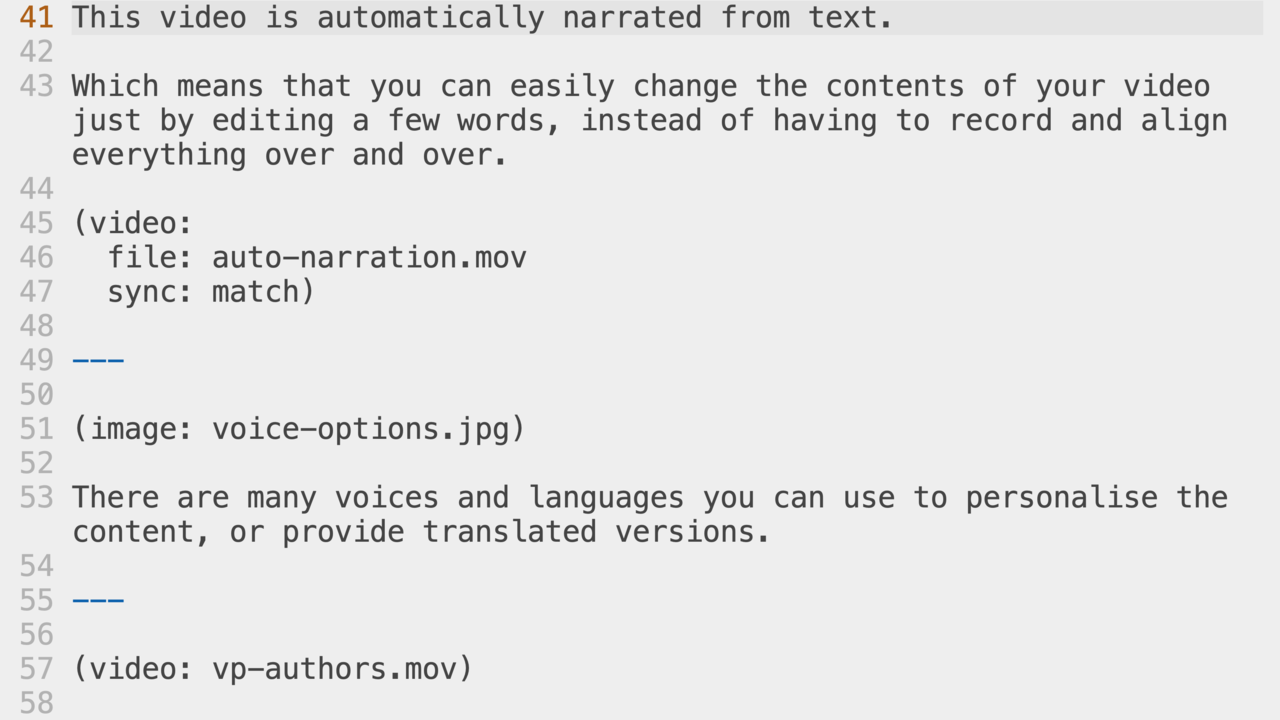Video Puppet makes it easy to script videos using plain text (Markdown) files.

Getting started
You can use Markdown, YAML or JSON format to create the script. We recommend using Markdown for manually created files (as it’s human-friendly), and JSON or YAML for automatically created script files (more machine-friendly). When working with Markdown files, make sure to name the file so it has the . Md or . mkd file extension.
Note: If you are not familiar with editing plain text files, create videos from PowerPoint presentations instead.
Start by creating a . Md text file and add some images or text into it. Upload the script file and the assets to Video Puppet.
Check out this sample script file . Video Puppet created the video below based on that script. Tweak the file then create a new video by uploading the modified file to the script wizard.
Check the
examples on GitHub
for ready- made demonstration scripts for key features.
Common tasks
Here is how to perform some common tasks as you start experimenting with Video Puppet:
You can add images or videos by using the standard Markdown syntax.
Adding narration)
Video Puppet automatically generates narration from the text in the markdown file. The following scene will include an image, and automatically generated voice narration:
! [] (london.jpg Welcome to LondonControl pronunciation and add pauses in the narration
Add a pause
stage direction between the paragraphs. The instruction should be in brackets, followed by a colon (
:) and a number of seconds you want to wait. It’s important to add this into a separate paragraph, so there needs to be a blank line between the instruction and the rest of the text. For example, to add a pause of 3 seconds between two sentences, add this to speaker notes:First sentence, something very interesting and amusing. (pause: 3) Second sentence, even more amusing.Check out the
Narration format reference for more information.
Using your own audio
Instead of automatically generated narration, you can add your own audio files, with recorded voice, music or something else to play during a scene. To do so, just add
(audio: file)in a separate paragraph. For example, this scene will show an image fromlondon.jpgand play the audio fromlondon-audio.mp3 :! [] (london.jpg (audio: london-audio.mp3)To add more scenes, use three or more dashes (
---) as a separator. The following script file creates two scenes:! [] (london.jpg Welcome to London! [] ( berlin.jpg Welcome to Berlin---Change the voice for a particular paragraph
Add a voice
stage direction between the paragraphs in your speaker notes to set the voice for the following text. The instruction should be in brackets, followed by a colon (
:) and a number of seconds you want to wait. It’s important to add this into a separate paragraph, so there needs to be a blank line between the instruction and the rest of the text. For example:First sentence, in the main video voice. (voice: Brian) Brian will read this sentence.Check out the
Narration format reference for more information.
Change the global video voice
You can add global video properties in the
script header , starting the script file with a scene separator (
---). The following script file sets the global voice for all scenes:voice :
brian! [] (london.jpgBrian will read this sceneMore examples
This is just a start. For a detailed list of things you can achieve with Video Puppet scripts, check out the format reference . Also, check the
examples on Github for ready-made demonstration scripts for key features.
(Read More
)





GIPHY App Key not set. Please check settings